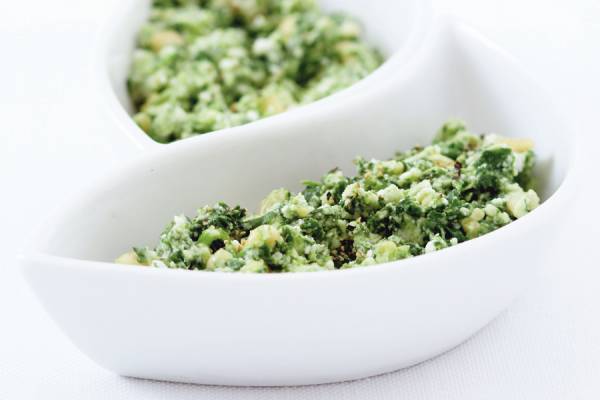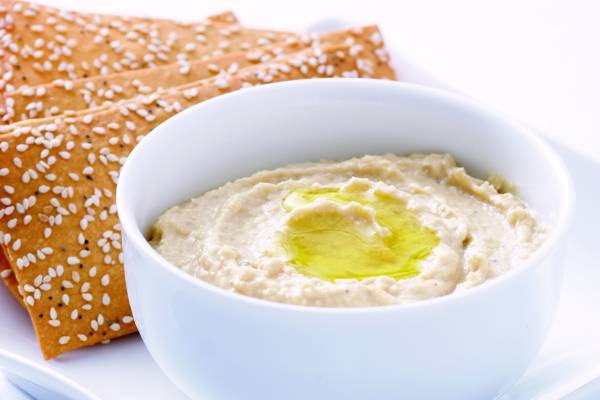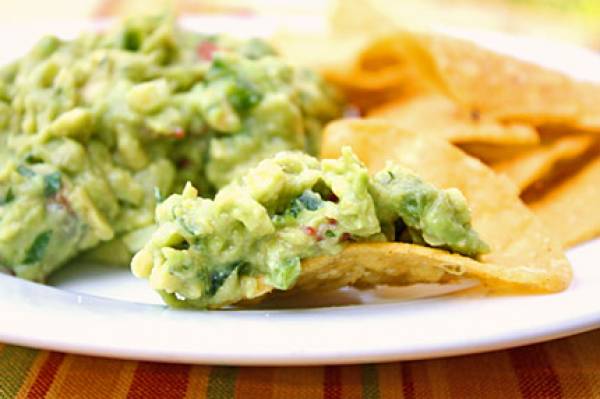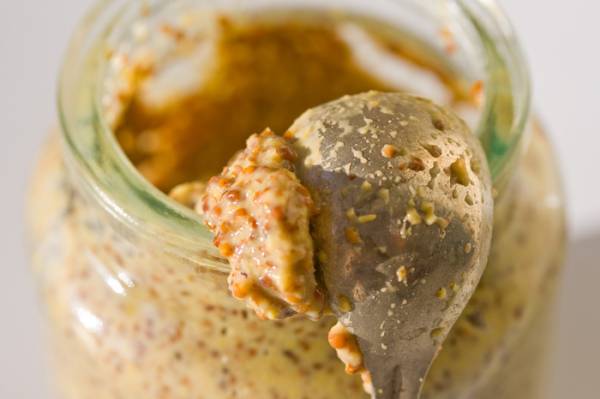Can food taste good and still be good for us? The PN chefs think so! Nutrient-packed condiments can make food delicious while still keeping us healthy and lean. Find out how to choose and prepare the best condiments — from pesto to hummus to salad dressing.
We all want food to taste great. Nobody (well, nobody besides a picky 3-year-old) can sustain a diet based around bland and boring food — no matter how “healthy” that food is.
So, to pump up the flavour, we often use condiments – stuff like ketchup, mayonnaise, guacamole, barbecue sauce, and more.
The good news: Some of these condiments are actually good for us!
You can probably guess the bad news, right? Some of them are not.
How can we get the best of both worlds — delicious food and good health?
That’s where the PN chefs come in. Here are three “healthy condiment” secrets from the PN kitchen.
What makes a great condiment?
First, a healthy condiment should be made up of mostly real foods.
Why? Because real foods provide phytontutrients, vitamins, minerals and fibre that will help make you more awesome.
Look for condiments that don’t contain a lot of added sugars and sodium. Some is okay, but sugar and salt should not be one of the first ingredients you see on the label. Also, don’t forget that sugar and salt go by many names. Read carefully, and look for anything that ends in “ose” — that’s sugar in disguise.
Second, if the condiment is a fat source, try to ensure that it is providing healthy fats.
Healthy fats include ingredients such as:
- extra virgin olive oil
- cold-pressed nut and seed oils
- avocado
Be wary of vegetable oils – corn, cottonseed, safflower, soybean, and sunflower. Also avoid “glycerides”, such as “mono- and diglycerides”, and anything called “hydrogenated”. These are the type of industrially processed fats that most of us need to minimize in our diets.
The last and most important feature of a great condiment?
It has to taste good!
Ok, so now that we know what makes a great condiment, let’s look at some examples.
Pesto
Traditional Italian pesto is made from basil, olive oil, garlic and pine nuts, but you can find many variations throughout the world. When made from extra-virgin olive oil (EVOO) it is a fantastic condiment, rich in taste and vitamins.
Remember, though, that not all store brands are made from EVOO. Read labels carefully, or better yet, make your own using this recipe from Gourmet Nutrition V2. It’s easy!
While pesto is calorie-dense and you should be aware of portion sizes, it provides a plethora of health benefits. Pesto also tends to be strongly flavoured, so a little goes a long way.
The extra-virgin olive oil is an excellent source of heart-healthy monounsaturated fats and phytonutrients known to have strong anti-inflammatory properties.
In addition, the basil in pesto has a variety of health benefits, as it’s:
- anti-viral and anti-bacterial;
- a strong anti-oxidant;
- anti-inflammatory; and
- a good source of vitamins A and K.
(Fun factoid: basil essential oil also repels mosquitos. Cool!)
Garlic is also immune-boosting and improves digestion and circulation.
Hummus
Hummus is a Middle Eastern spread that is typically made with cooked, mashed chickpeas and blended with sesame tahini, lemon juice, olive oil, lemon juice, salt and garlic. For a great home-made hummus recipe, check out: Yummy Hummus from Gourmet Nutrition V2
As with pesto, the olive oil in hummus provides a nice dose of healthy fats and anti-inflammatories. The chickpeas (also known as garbanzo beans) are also a good source of fiber, molybdenum, manganese, and folate.
Molybdenum in particular has some interesting properties. We don’t fully understand how it works, but in animal studies it has shown promise in reducing the harmful effects of certain cancer drugs on the heart and lungs. Pretty cool stuff.
Guacamole
Guacamole is an awesome condiment. Why? It’s made almost entirely from produce!
While recipes can vary somewhat, the main ingredient is always avocado. Avocados, and therefore guacamole, provide heart-healthy monounsaturated fats (much like olive oil), and contain an amazing array of phytonutrients, including some very powerful carotenoids, beta-sitosterols, and more.
These phytonutrients in avocados are known to have powerful anti-inflammatory properties. They improve eye health, and are associated with a decreased risk of cancer of the mouth, breast, and prostate. In addition, avocados are a good source of fibre, potassium, and lutein as well as 22 other essential nutrients!
One great way to use guacamole is in place of mayonnaise. It provides the same creamy texture, but is less calorie-dense. Plus – bonus – it provides a serving of produce. Best of all, it tastes awesome and is easy to make!
Mustard
Mustard seeds are members of the Brassica family, just like broccoli, cabbage and Brussel sprouts. Like other members of that family, mustard seeds contain plentiful amounts of phytonutrients, specifically a class called glucosinolates. In addition, mustard seeds contain an enzyme that can turn these glucosinolates into substances called isothiocyanates.
Isothiocyanates have been extensively researched for their strong anti-cancer effects. In animal studies, intake of isothiocyanates has been shown to slow down or decrease the growth of existing cancer cells and to protect against the formation of new cancers. The data is particularly strong in colorectal cancer and cancers of the gastrointestinal tract.
Do be mindful, though, that mustard often has a fair amount of sodium added to it, so it is not necessarily a food to eat to your heart’s content. If you have special concerns, you might want to make your own. That way, you can control the sodium levels.
What about…?
Pesto, hummus, guacamole, and mustard are not the only healthy condiments. Salsa, tzatziki, chutney, and many others can also be good choices.
You can also add ketchup to that list. Yes, ketchup! While it often gets a bad rap, in a reasonable portion size, ketchup can actually be a relatively good choice, due to its lycopene content.
However, processed ketchup does contain a fair amount of added sugar and salt, so be mindful of the portion size. Or better yet, make your own.
Salad dressings can also be sources of healthy fats when they are made with appropriate oils or foods, but store-bought versions often tend to be made with low-quality oils. In addition they are very calorie-dense and easy to over-consume, so being mindful of portion is paramount.
Again, making your own dressing is the best way to ensure its quality. Here are some great home-made dressings from Gourmet Nutrition.
Summary and recommendations
Making our food taste great helps us maintain healthy eating habits. And using tasty condiments appropriately can provide a wonderful treat to the palate.
In addition, ensuring that our condiments are nutrient-rich will help us meet our health and fitness goals.
Remember always to keep portion sizes in mind, and to check the labels to make sure condiments are made from mostly real food, with minimal added sugars and sodium. And if the condiment is a source of fat, ensure it’s a healthy fat like extra virgin olive oil, expeller pressed canola oil, or avocado.
Bonus
Though many store-bought brands of condiments can be healthy, there’s nothing like making your own condiments in the comfort of your own kitchen.
You can completely control the ingredients and method of preparation. This means you can make a product that is lower in calories, sugar, and sodium with fewer (or no) artificial ingredients.
Plus you can tweak recipes to suit your unique tastes and preferences.
With over 100 new recipes, Gourmet Nutrition V2 includes 8 incredible condiments and 10 dressings that are made with real food, provide healthy fats, and taste mouth-wateringly awesome! These recipes include salsa, pesto, hummus, chutney, vinaigrettes, and more.
Get a copy, read it through, and try it out – we know you’ll love it!
Learn more
Want to get in the best shape of your life, and stay that way for good? Check out the following 5-day body transformation courses.
The best part? They're totally free.
To check out the free courses, just click one of the links below.








Share